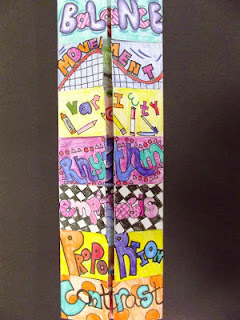Elements of Art and Principles of Design Assignment
Create a foldable for the Elements of Art listed below.
Fold your piece of paper long ways into thirds. Use a ruler to mark areas to cut slits in paper for each element of art. When the foldable is closed is should show a title for each element of art. When you open the tabs, write the definition of the element of art inside the area. This will be helpful for our Elements of Art and Principles of Design QUIZ.
Shape:
Color:
Value:
Texture:
Space:
Form:
Fold your piece of paper long ways into thirds. Use a ruler to mark areas to cut slits in paper for each element of art. When the foldable is closed is should show a title for each element of art. When you open the tabs, write the definition of the element of art inside the area. This will be helpful for our Elements of Art and Principles of Design QUIZ.
Elements of art are the ingredients to create art.
Line:
A line is a path made by a moving point through space. It is one-dimensional and can vary in width, direction, and length.
Shapes are flat, enclosed areas that are two-dimensional (length and height). Artists use both geometric and organic shapes.
Color
is perceived by the way light reflects off a surface. There are three
properties of color: hue (color name), intensity (strength/purity), and
value (lightness and darkness).
Value describes the lightness or darkness of a surface.
Texture
describes the surface quality of an object. Artists use both actual
texture (how things feel) and implied texture (how things look like they
feel).
Space
is used to create the illusion of depth within an artwork. It can also
refer to the positive and negative space between, around, or within
objects.
Forms are three-dimensional (length, width, height) and can be viewed from many angles. Forms have volume and take up space.
Balance is the distribution of visual weight in an artwork. The three types of balance are symmetrical (two sides are the same), asymmetrical (two sides are different but visually weighted equally) and radial (design emerges from center point).
Here is a file you can download with the definitions of Elements of Art:
https://www.theartofed.com/content/uploads/2015/12/The-Elements-of-Art.pdf
Here is a file you can download with the definitions of the Principles of Design:
https://www.theartofed.com/content/uploads/2015/12/The-Principles-of-Art.pdf
Here are some examples:
Principles of design are the tools that piece together the elements of art to create art.
Balance: Balance is the distribution of visual weight in an artwork. The three types of balance are symmetrical (two sides are the same), asymmetrical (two sides are different but visually weighted equally) and radial (design emerges from center point).
Contrast:
Contrast is the difference between elements in a composition. This can happen through a variety of elements such as value change, size difference, etc.
Contrast is the difference between elements in a composition. This can happen through a variety of elements such as value change, size difference, etc.
Emphasis:
Emphasis is the creation of a focal point in an artwork. Emphasis draws the viewer’s eye to particular areas of the artwork first.
Pattern:
Pattern decorates the artwork with regularly repeated elements such as shapes or color.
Unity:
Unity means that all elements within the artwork are in harmony. Variety within elements adds interest to the composition.
Movement:
Movement is how the eye travels through an artwork. Movement can lead the viewer from one aspect to another within the composition.
Rhythm:
Rhythm is the regular repetition of elements such as line, shape and forms to
create interest and consistency.
This is a great video series on the Elements of Art and Principles of Design:
https://www.youtube.com/playlist?list=PLUPyLCL_r37YfalHGuBUXBzbaGO6l4tef
Emphasis is the creation of a focal point in an artwork. Emphasis draws the viewer’s eye to particular areas of the artwork first.
Pattern:
Pattern decorates the artwork with regularly repeated elements such as shapes or color.
Unity:
Unity means that all elements within the artwork are in harmony. Variety within elements adds interest to the composition.
Movement:
Movement is how the eye travels through an artwork. Movement can lead the viewer from one aspect to another within the composition.
Rhythm:
Rhythm is the regular repetition of elements such as line, shape and forms to
create interest and consistency.
This is a great video series on the Elements of Art and Principles of Design:
https://www.youtube.com/playlist?list=PLUPyLCL_r37YfalHGuBUXBzbaGO6l4tef
https://www.theartofed.com/content/uploads/2015/12/The-Elements-of-Art.pdf
Here is a file you can download with the definitions of the Principles of Design:
https://www.theartofed.com/content/uploads/2015/12/The-Principles-of-Art.pdf
Here are some examples:



Comments
Post a Comment